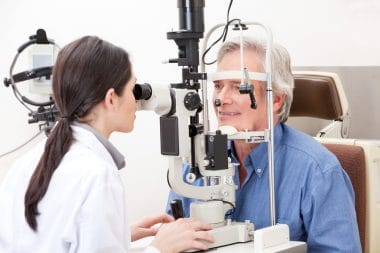Stargardt disease is a genetic disorder that is the most common inherited form of macular degeneration. Stargardt disease causes retinal degeneration and vision loss. There are about 30,000 cases in the United States. Stargardt disease affects both eyes and causes progressive vision loss. This is because the photoreceptor cells degenerate. The retina is the light sensitive tissue lining in the back of the eye. This disease is genetic, meaning it is passed on to the children of parents who both have the gene mutation. The parents with the gene mutation don’t have to have the disease, it can be recessive where they show no signs or symptoms of the disease. Â
Stargardt disease usually presents itself in younger children. Children usually realize they are having trouble reading or adjusting to light. It is then usually diagnosed during a normal eye exam. Symptoms can start as early as 6 years old, but sometimes don’t show up until your twenties. How fast the disease progresses is kind of dependent on the person, sometimes it could be diagnosed at an early age, but no severe vision loss happens until middle aged. Â
Symptoms
Symptoms can include blurred vision, distorted vision, inability to see in low lighting, difficulty recognizing faces, color vision loss, and central vision develops blur spots. Usually the first symptoms that present are the blurred vision, and difficulty adjusting to light. The progression of the disease differs per person. Â
Diagnosis
Your eye doctor will be able to diagnose Stargardt disease from an exam of the back of the eye. The retina will show elongated, white, branching flecks. Your doctor can put dilation drops in your eye so they can get a good look at your retina to see if your retina shows these signs.Â
Another test your doctor can run is Indocyanine green angiography which determines the type of macular degeneration you have. Two other tests your doctor may want to do is the Asmier grid testing and the Optical coherence tomography, these help determine how much macular degeneration is affecting your vision. Â
Lifestyle & Treatment Options
There is no known treatment at this time for Stargardt disease. Though there are clinical trials that are trying to find some treatment options for people who suffer from this.Â
Your doctor may suggest doing some things that would help treat other types of macular degeneration. These would be no smoking, routine eye exams, exercise regularly, and a vitamin regimen. Vitamins that can be helpful for eye health are Vitamin C, Lutein, Zinc, Vitamin E, Zeaxanthin, and Copper. Only take these supplements if your doctor suggests it.Â
Your doctor may also want you to wear tinted glasses. Tinted glasses that block 100% of UV light can be helpful.Â
There is a clinical trial that is researching the buildup of Vitamin A in the eyes in people with macular degeneration. It shows that this buildup may lead to the degeneration, so the trial is to help slow down the buildup of this Vitamin A in your eyes.Â
Another clinical trial is doing stem cell treatment on people with Stargardt’s disease. Hopefully soon there will be a treatment.Â
Outcomes
People who suffer from Stargardt disease can still live full lives. Children may need large print books at school or special devices that magnify the books for easy reading. Your doctor will most likely want you to wear some type of eyewear to block out the light waves. This will help your eyes and their sensitivity to light.Â
Overtime though if the degeneration gets too severe you do risk going completely blind. This may happen quickly or for many years. There is no cure for this disease, but diagnosing it is easy with just an eye exam.Â
Stargardt disease is the most common genetic form of macular degeneration and with so much research and clinical trials being done to learn more about it, hopefully soon there will be a treatment. Â
Stargardt disease causes retinal degeneration and vision loss! #HealthStatus
Usually the first symptoms that present are the blurred vision, and difficulty adjusting to light.Â
Sources:
https://www.fightingblindness.org/diseases/stargardt-disease?gclid=CjwKCAjw47eFBhA9EiwAy8kzNHh58jXb5aOWaltMTKJGWzuJHs21YEgX3MVAq767f9StC7KoXjMPBBoCOAMQAvD_BwE
https://medlineplus.gov/genetics/condition/stargardt-macular-degeneration/
https://www.allaboutvision.com/conditions/stargardts.htm
https://www.fightingblindness.org/diseases/stargardt-disease
https://www.macular.org/stargardt-disease
https://www.nvisioncenters.com/conditions/stargardt-disease/









Reply